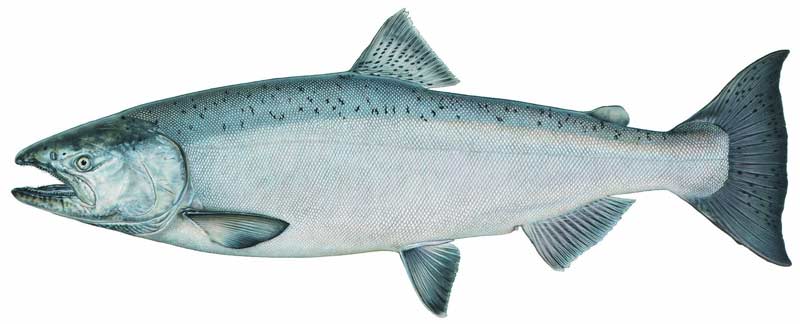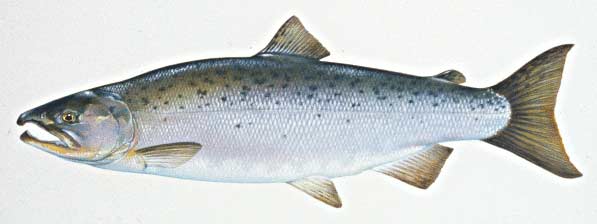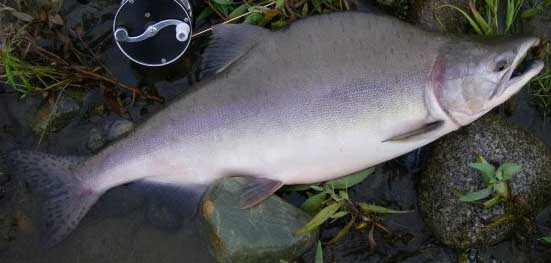More WildSalmon.com Information
Alaska
Salmon begin their lives in the freshwater streams, rivers, and lakes of Alaska
before migrating to the ocean, where they remain until it is time to return to
their freshwater birthplace in order to reproduce.
Salmon Life
Cycle
: A female salmon
nests in the gravel at the bottom of a stream, river, or lake and then deposits
her eggs. The eggs are fertilized by a male salmon and hatch eight to
twelve weeks later. When the eggs hatch, alevins emerge and live in the
gravel for several weeks. The alevins survive by eating their egg yolk
sacks until they become fry and begin eating bugs. The young salmon
typically live in fresh water for one to three years before venturing out into
the sea. The salmon then live in the ocean for between one and seven
years before returning to spawn.
General description: Moose are long-legged and heavy bodied with a drooping nose, a fold of
hair-covered skin called a “dewlap” or “bell” under the chin, and a short tail.
Their color ranges from golden brown to almost black, depending upon the season
and the age of the animal. The hair of newborn calves is generally red-brown
fading to a lighter rust color within a few weeks. By late summer, calves have
shed their rust colored coat which is replaced with hair that is similar in
texture and color to that of adults. Adult males are larger than the females
and in prime condition weigh from 1,200 to 1,600 pounds (542 to 725 kg). Adult
females weigh 800 to 1,300 pounds (364 to 591 kg).
Only the males or “bulls”
have antlers. Most male calves develop a hair-covered, bony protuberance by the
end of summer that persists through their first year. Following this initial
development, antlers are grown each summer and shed during winter throughout
the bull’s life. The largest moose antlers in North America come from Alaska,
the Yukon Territory, and the Northwest Territories of Canada. Trophy age class
bulls with antlers 50 inches (127 cm) in spread or larger are found throughout
Alaska. Moose occasionally produce trophy-size antlers when they are 6 or 7
years old, with the largest antlers grown at approximately 10 to 12 years of
age.
Moose communicate through
a variety of vocalizations, noises, body posturing, and odors. Moose rarely
live more than 16 years.
Life history: Growth patterns, age at sexual maturity, and production of offspring
are closely tied to range conditions. Female or “cow” moose generally breed at
28 months, though some may breed as young as 16 months. Calves are born any
time from mid- May to early June after a gestation period of about 230 days. A
cow moose defends her newborn calf vigorously. Cows give birth to twins <10
to 75 percent of the time, and triplets may occur. Newborn calves generally
weigh 28 to 35 pounds (13-16 kg) and rarely as much as 45 pounds (22 kg).
Calves begin nursing within the first few hours following birth and take solid
food a few days later. During their first 5 months, while suckling and
foraging, calves will grow to more than 10 times their birth mass; occasionally
weighing more than 500 pounds (227 kg). Calves are generally weaned in the fall
at the time the mother is breeding again.
The maternal bond is
generally maintained until calves are 12 months old at which time the mother
aggressively chases her offspring from the immediate area just before she gives
birth. Moose breed in the fall with the peak of the “rut” activities coming in
late September and early October. Adult males joust during the rut by bringing
their antlers together and pushing. Serious battles are rare, but bulls
regularly receive a few punctures, sometimes break ribs, and occasionally die
from their wounds. The winner usually mates with several females.
By late October, adult
males have exhausted their summer accumulation of fat and their desire for
female company. Once again they begin feeding. Antlers from mature bulls are
shed as early as November, but mostly in December and January. Young bulls may
be seen with their antlers as late as April.
Food habits: During fall and winter, moose consume large quantities of willow,
birch, and aspen twigs. In some areas, moose actually establish a “hedge” or
browse line 6 to 8 feet above the ground by clipping most of the terminal
shoots of favored food species. Spring is the time of grazing as well as
browsing. Moose eat a variety of foods, particularly sedges, equisetum
(horsetail), pond weeds, and grasses. During summer, moose feed on vegetation
in shallow ponds, forbs, and the leaves of birch, willow, and aspen.
Movements: Most moose make seasonal movements to calving, rutting, and wintering
areas. They travel anywhere from only a few miles to as many as 60 miles during
these transitions.
Population dynamics: Moose have a high reproductive potential and can quickly overpopulate a
range if not limited by predation, hunting, and severe weather. Deep crusted
snow can lead to malnutrition and subsequent death of hundreds of moose and
decrease the survival of the succeeding year's calves.
Moose are killed by
wolves, black and brown bears. Black bears take moose calves in May and June.
Brown bears kill calves and adults the entire time the bears are out of their
winter dens. Wolves kill moose throughout the year. Predation limits the growth
of many moose populations in Alaska.
Economic and future
status: Because moose range over so much
of Alaska, they have played an important role in the development of the state.
At one time professional hunters supplied moose meat to mining camps.
Historically, moose were an important source of food, clothing, and implements
to Athapaskan Indians dwelling along the major rivers. Today, more people hunt
moose than any other of Alaska's big game species. Alaskans and nonresidents
annually harvest approximately 6,000 to 8,000 moose, some 3.5 million pounds of
meat. Moose are an important part of the Alaskan landscape, and tourists
photograph those animals that feed along the highway.
Human developments in
Alaska include many alterations upon the face of the land. These activities
create conflicts between people and moose as moose eat crops, stand on
airfields, eat young trees, wander the city streets, and collide with cars and
trains.
Removal of mature timber
through logging and careless use of fire has, in general, benefited moose as
new stands of young timber have created vast areas of high-quality moose food.
The future for moose is reasonably bright, however, moose management has become
increasingly complex as the allocation dilemma has intensified. Agencies are
challenged to develop socially responsive plans that recognize and accommodate
diverse uses and values for moose.





